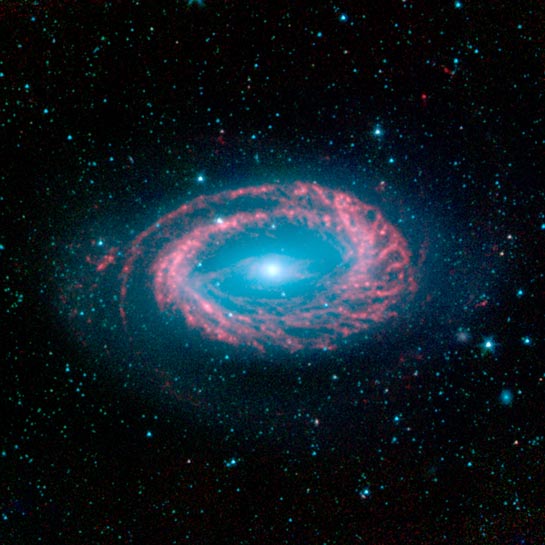
Spiral galaxy
RA 12h 50m 18.5s Dec 25° 25' 27.1"
Coma Berenices
41million Light Years
10.1
10.7 by 7.6 arcmin
12.2 x 12.2 arcminutes
North is 55.2° left of vertical
NASA/JPL-Caltech/R. Kennicutt (U of Arizona) & the SINGS Team
August 25, 2005
ABOUT THIS IMAGE:
On August 25, 2003, NASA's Spitzer Space Telescope blasted into the same dark skies it now better understands. In just two years, the observatory's infrared eyes have uncovered a hidden universe teeming with warm stellar embryos, chaotic planet-forming disks, and majestic galaxies, including the delightfully odd galaxy called NGC 4725 shown here.
This peculiar galaxy is thought to have only one spiral arm. Most spiral galaxies have two or more arms. Astronomers refer to NGC 4725 as a ringed barred spiral galaxy because a prominent ring of stars encircles a bar of stars at its center (the bar is seen here as a horizontal ridge with faint red features). Our own Milky Way galaxy sports multiple arms and a proportionally smaller bar and ring.
In this infrared Spitzer picture, the galaxy's arm is highlighted in red, while its center and outlying halo are blue. Red represents warm dust clouds illuminated by newborn stars, while blue indicates older, cooler stellar populations. The red spokes seen projecting outward from the arm are clumps of stellar matter that may have been pushed together by instable magnetic fields.
NGC 4725 is located 41 million light-years away in the constellation Coma Berenices. It was discovered by William Herschel on April 6, 1785
This picture is composed
of four images taken by Spitzer's infrared array camera at 3.6 (blue),
4.5 (green), 5.8 (red), and 8.0 (red) microns. The contribution from starlight
(measured at 3.6 microns) has been subtracted from the 5.8- and 8-micron
images to enhance the visibility of the dust features.